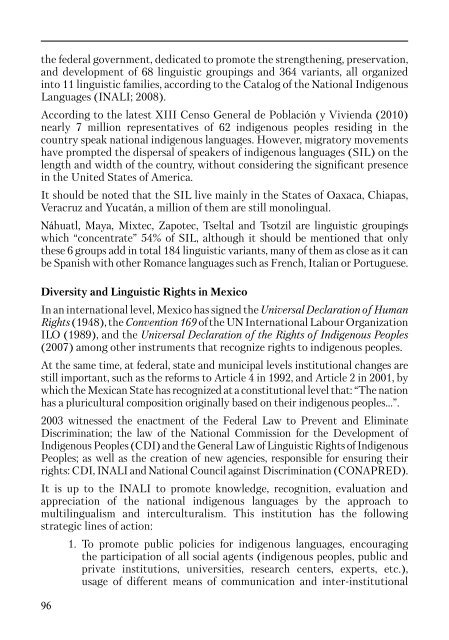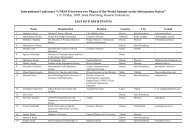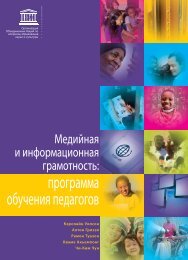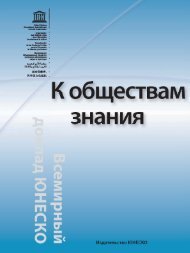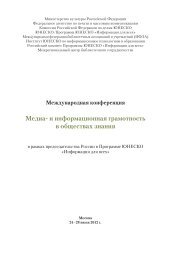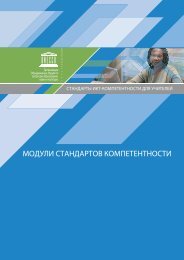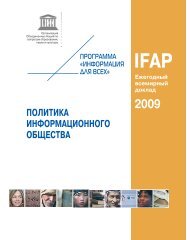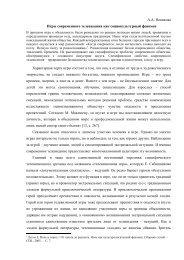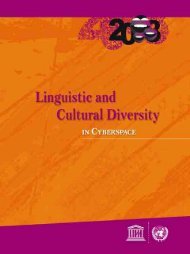Download - РоÑÑийÑкий комиÑÐµÑ ÐÑогÑÐ°Ð¼Ð¼Ñ Ð®ÐÐСÐÐ ...
Download - РоÑÑийÑкий комиÑÐµÑ ÐÑогÑÐ°Ð¼Ð¼Ñ Ð®ÐÐСÐÐ ...
Download - РоÑÑийÑкий комиÑÐµÑ ÐÑогÑÐ°Ð¼Ð¼Ñ Ð®ÐÐСÐÐ ...
Create successful ePaper yourself
Turn your PDF publications into a flip-book with our unique Google optimized e-Paper software.
the federal government, dedicated to promote the strengthening, preservation,<br />
and development of 68 linguistic groupings and 364 variants, all organized<br />
into 11 linguistic families, according to the Catalog of the National Indigenous<br />
Languages (INALI; 2008).<br />
According to the latest XIII Censo General de Población y Vivienda (2010)<br />
nearly 7 million representatives of 62 indigenous peoples residing in the<br />
country speak national indigenous languages. However, migratory movements<br />
have prompted the dispersal of speakers of indigenous languages (SIL) on the<br />
length and width of the country, without considering the significant presence<br />
in the United States of America.<br />
It should be noted that the SIL live mainly in the States of Oaxaca, Chiapas,<br />
Veracruz and Yucatán, a million of them are still monolingual.<br />
Náhuatl, Maya, Mixtec, Zapotec, Tseltal and Tsotzil are linguistic groupings<br />
which “concentrate” 54% of SIL, although it should be mentioned that only<br />
these 6 groups add in total 184 linguistic variants, many of them as close as it can<br />
be Spanish with other Romance languages such as French, Italian or Portuguese.<br />
Diversity and Linguistic Rights in Mexico<br />
In an international level, Mexico has signed the Universal Declaration of Human<br />
Rights (1948), the Convention 169 of the UN International Labour Organization<br />
ILO (1989), and the Universal Declaration of the Rights of Indigenous Peoples<br />
(2007) among other instruments that recognize rights to indigenous peoples.<br />
At the same time, at federal, state and municipal levels institutional changes are<br />
still important, such as the reforms to Article 4 in 1992, and Article 2 in 2001, by<br />
which the Mexican State has recognized at a constitutional level that: “The nation<br />
has a pluricultural composition originally based on their indigenous peoples…”.<br />
2003 witnessed the enactment of the Federal Law to Prevent and Eliminate<br />
Discrimination; the law of the National Commission for the Development of<br />
Indigenous Peoples (CDI) and the General Law of Linguistic Rights of Indigenous<br />
Peoples; as well as the creation of new agencies, responsible for ensuring their<br />
rights: CDI, INALI and National Council against Discrimination (CONAPRED).<br />
It is up to the INALI to promote knowledge, recognition, evaluation and<br />
appreciation of the national indigenous languages by the approach to<br />
multilingualism and interculturalism. This institution has the following<br />
strategic lines of action:<br />
1. To promote public policies for indigenous languages, encouraging<br />
the participation of all social agents (indigenous peoples, public and<br />
private institutions, universities, research centers, experts, etc.),<br />
usage of different means of communication and inter-institutional<br />
96


